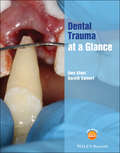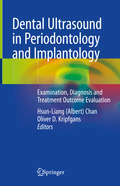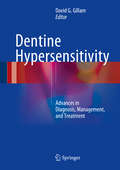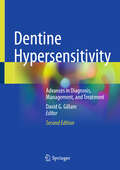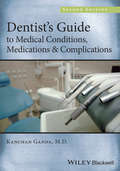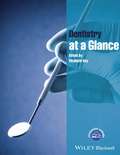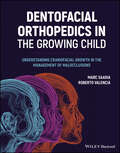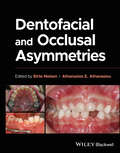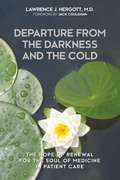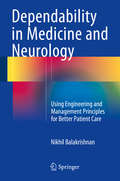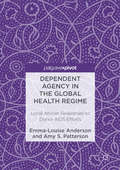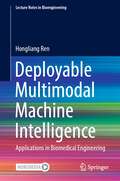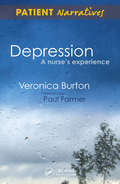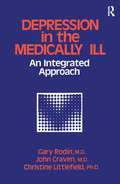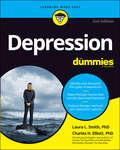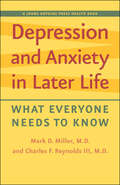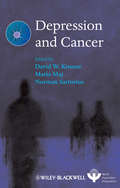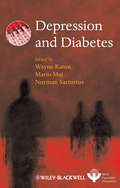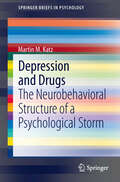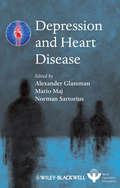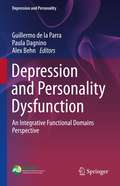- Table View
- List View
Dental Trauma at a Glance (At a Glance (Dentistry))
by Aws Alani Gareth CalvertDental Trauma at a Glance The market‐leading at a Glance series is popular among students and newly qualified practitioners for its concise and simple approach and excellent illustrations.Each bite‐sized chapter is covered in a double‐page spread with clear, easy‐to‐follow diagrams, supported by succinct explanatory text.Covering a wide range of topics, books in the at a Glance series are ideal as introductory texts for teaching, learning and revision and are useful throughout university and beyond.Everything you need to know about Dental Trauma … at a Glance! Written in a short and concise manner, Dental Trauma at a Glance is a practical reference that contains essential information on the safe and effective clinical management of acute adult dental trauma injuries.The book addresses the numerous types of adult dental injuries and contains guidance on how the correct identification and treatment of these injuries can be time sensitive. Filled with helpful illustrations and photographs, the text is formatted in a step-by-step manner for the reader to arrive at the correct diagnosis and the most up-to-date management for safe and optimum patient care.Provides the most contemporary must-have information for the clinical management of acute adult dental traumaIts format is quick and easy to useOffers a highly illustrated text with quality clinical photographs to aid with learning and revisionProvides an understanding of traumatic adult dental injuries, their healing and an insight into their longer-term sequelaeA new addition to the popular at a Glance series, Dental Trauma at a Glance is an indispensable hands-on guide for dental students and general dental practitioners. Accompanied by a companion website at www.wiley.com/go/alani/dental_trauma featuring:Multiple-choice questions to aid learningAll figures from the book as downloadable PowerPoint slides
Dental Ultrasound in Periodontology and Implantology: Examination, Diagnosis and Treatment Outcome Evaluation
by Hsun-Liang Albert Chan Oliver D. KripfgansThis book presents up-to-date information on promising indications for ultrasound in contemporary periodontics and implant therapy with the aim of assisting researchers and dental practitioners to use this novel imaging modality to advance research and patient care. Readers will find clear guidance on the application of ultrasound for evaluation of periodontal and peri-implant tissues. The mechanism of ultrasound imaging is explained in detail and compared to other imaging modalities. Furthermore, the role of ultrasound in the planning and execution of implant surgery and the assessment of implant stability is discussed. The book closes by considering the potential dental applications of functional ultrasound and volumetric ultrasound. This book will potentially be of high values for dental surgeons, periodontists, general dentists, orthodontists, dental hygienists, dental assistants, dental researchers and other practitioners, etc.
Dentine Hypersensitivity
by David G. GillamThis book provides wide-ranging information on the progress achieved in the diagnosis, treatment and management of dentine hypersensitivity during the past few years. Recent advances in research, including innovations in the development of desensitizing agents, are fully described and detailed attention is paid to novel clinical approaches and potential future strategies in product development. Introductory chapters cover important aspects of physiology, prevalence and aetiology and advances in diagnosis and in vitro testing techniques for dentine hypersensitivity are discussed. Dentine hypersensitivity is a troublesome clinical condition that continues to perplex the clinician despite the vast array of available treatments that have been formulated to resolve the problem. There continues to be under-reporting of the condition by clinicians and uncertainty over aetiology, diagnosis and effective management. This book will hopefully contribute in combating these deficiencies and assist the clinician in delivering optimal patient care.
Dentine Hypersensitivity: Advances in Diagnosis, Management, and Treatment
by David G. GillamThis book, now in an extensively revised second edition, provides wide-ranging information on the progress achieved in the diagnosis, treatment, and management of dentine hypersensitivity during the past few years. Recent advances in research, including innovations in the development of desensitizing agents, are fully described and detailed attention is paid to novel clinical approaches and potential future strategies in product development. Introductory chapters cover important aspects of physiology, prevalence and aetiology and advances in diagnosis and in vitro testing techniques for dentine hypersensitivity are discussed. Dentine hypersensitivity is a troublesome clinical condition that continues to perplex the clinician despite the vast array of available treatments that have been formulated to resolve the problem. There continues to be under-reporting of the condition by clinicians and uncertainty over aetiology, diagnosis, and effective management. This book will hopefully contribute to combating these deficiencies and assist the clinician in delivering optimal patient care.
Dentist's Guide to Medical Conditions, Medications and Complications
by Kanchan GandaThe second edition of Dentist's Guide to Medical Conditions, Medications and Complications continues to provide quick-access, clinical information on the dental treatment of patients with common systemic conditions and medical complications. Expanded in this second edition is information about patient medications. Ideal for general practitioners and students in advanced general dentistry programs, the book outlines protocols for treating patients with common conditions, presents essential drug interaction information, and guides the dental professional through prevention and management of in-office medical emergencies.
Dentistry at a Glance
by Elizabeth KayA fully illustrated, concise and accessible introduction to the study of dentistry Central title in the At a Glance series for dentistry students Covers the entire undergraduate clinical dentistry curriculum Topics presented as clear double-page spreads in the recognizable At a Glance style Contributions from leading figures across the field of dentistry Companion website with self-assessment MCQs and further reading
Dentistry in Rabbits and Rodents
by Estella BöhmerDentistry in Rabbits and Rodents is a practical guide aimed at helping clinicians successfully diagnose and treat dental problems in rabbits and rodents within their own surgeries. With over two-thirds of small mammals presenting with tooth related problems, there is great potential to enhance the treatment offered to the owners of these species. Focusing on innovative diagnostics using normal radiographic machines as well as specific positioning techniques, radiographs are presented with reference lines and detailed annotations. Richly illustrated with high quality photographs, pathological findings are described before selection of appropriate therapy and treatment is discussed. Key features include: Covers the dental anatomy and physiology of all small mammal species commonly kept as pets. Intraoral radiography and innovative positioning for imaging the guinea pig and chinchilla dentitions are described, enabling the practitioner to visualize each tooth in detail. Once a diagnosis has been reached, selection of different treatments and the advantages and disadvantages of each surgical technique are discussed. Offers helpful directives for approaching and treating dental disease without the need for referral to a specialist or the use of expensive equipment.
Dentofacial Anomalies: Implications for Voice and Wind Instrument Performance
by Valerie Trollinger Robert Thayer Sataloff Mary J. Hawkshaw Abdul Latif HamdanThis volume provides an eloquent review of the anatomy and physiology of phonation, the work-up of patients with voice disorders, basic evaluation of wind instrument performance and dysfunction, and a full description of the most common skeletal and non-skeletal dentofacial anomalies, including their means of diagnosis and treatment. This is followed by a comprehensive review of literature on the vocal and acoustic features of affected patients, as well as the special considerations in wind instrumentalists. The effect of orthodontic therapy/ orthognathic surgery on voice, associated upper airway changes, and wind instruments performance is emphasized. The information provided in this book will heighten the patients’, therapists’, teachers’ and physicians’ awareness of the vocal characteristics and wind instrumentalists concerns often associated with these conditions. Dentofacial Anomalies: Implications for Voice and Wind Instrument Performance is addressed to otolaryngologists, laryngologists, speech-language pathologists, voice teachers, professional voice users, wind instrumentalists, instrument teachers, arts medicine physicians, physical therapists, orthodontists and other dentists, as well as members of the general public who are concerned about their voices and or wind instrument playing.
Dentofacial Orthopedics in the Growing Child: Understanding Craniofacial Growth in the Management of Malocclusions
by Marc Saadia Roberto ValenciaDENTOFACIAL ORTHOPEDICS IN THE GROWING CHILD A clinical guide to understanding why malocclusions occur in children and how to diagnose and correct them early to reestablish normal growth using dentofacial orthopedics Dentofacial Orthopedics in the Growing Child: Understanding Craniofacial Growth and the Management of Malocclusion provides step-by-step guidance on diagnosing and treating malocclusions in young patients. The book addresses both class I, II and III malocclusions, and more complicated cases such as facial asymmetries and temporomandibular problems that develop in the primary dentition. Concise, highly illustrated chapters describe normal and abnormal craniofacial development, and how and why environmental factors can affect the growth pattern. Early diagnosis and treatment planning, long-term case resolution, complementary methods of diagnosis such as occlusion and cephalometric, and more are discussed. Provides clinicians with visual guidance on how to rapidly diagnose malocclusions Contains over 1,300 high-quality images of different Class I, Class II, and Class III malocclusions, including temporomandibular problems, both before and after correction, and long-term follow-ups Helps clinicians correct different malocclusions using the fewest number of appliances and in the least amount of time Includes tables of different cephalometric of before and after corrections for most clinical cases presented in the book Contains a chapter on how to communicate and bond with children as patients to help them understand the importance of wearing their appliances Children are not young adults so diagnostic methods which are regularly used can often misguide the clinician. Dentofacial Orthopedics in the Growing Child is an invaluable reference that guides pediatric dentists, orthodontists, general dentists, and maxillofacial and craniofacial surgeons with treating children.
Dentofacial and Occlusal Asymmetries
by Birte Melsen Athanasios E. AthanasiouComprehensive and accessible resource that covers all crucial aspects of dentofacial and occlusal asymmetries Dentofacial and Occlusal Asymmetries covers all crucial aspects of asymmetries encountered in the stomatognathic region regarding diagnosis, treatment planning, management, and prognosis. Divided into three core sections, the first part focuses on the etiology of asymmetry and whether it is congenital or acquired through disease or trauma. The second and third sections go on to discuss localization and management, providing information on topics such as interception, correction, and camouflage. Specific sample topics covered in the book include: Treatment approaches: interceptive, tooth movements, goal-oriented biomechanics, and jaw repositioningTreatment principles: dentofacial orthopedics, camouflage, and orthodontic-surgical treatmentLocalization and problem list: medical and dental history, clinical examination, dental cast analysis, and radiographic/imaging assessmentMedical, social and psychological aspects: growth disorders and helping children and their families with facial differences Written by a team of renowned experts in the field, Dentofacial and Occlusal Asymmetries will serve as an invaluable resource to postgraduates in orthodontic, pediatric dentistry, and oral and maxillofacial surgery programs as well as orthodontists, pediatric dentists, pediatricians, and oral and maxillofacial surgeons aiming for optimal results in the diagnosis and management of these complex malocclusions and dentofacial deformities.
Departure from the Darkness and the Cold: The Hope of Renewal for the Soul of Medicine in Patient Care
by Lawrence J. HergottIn the midst of the cold and dark in the current practice of medicine there is a glimmer of hope called the soul of medicine - comprehensive, compassionate, patient-clinician interactions focused solely on the needs of the patient - that can warm and enli
Dependability in Medicine and Neurology
by Nikhil BalakrishnanThis ground-breaking title presents an interdisciplinary introduction to the subject of Dependability and how it applies in medicine generally and in neurology in particular. Dependability is the term applied in engineering and industry to a service that is safe, reliable and trustworthy. Dependable systems use a variety of methods to deliver correct service in the face of uncertainty resulting from misleading, erroneous information, and system faults. Dependable systems result from the application of systematic methods in design, operation, and management to deliver their services. Dependability in Medicine and Neurology presents the philosophy and ideas behind the specific methods of dependability and discusses the principles in the context of medical care and neurologic treatment especially. Patient case vignettes are used widely to illustrate key points. A first-of-its-kind title and based on the author's many years of teaching these principles to medical colleagues throughout the United States, Dependability in Medicine and Neurology will inspire readers to develop applications for their specific areas of clinical practice. Intended for physicians (especially neurologists), medical students, nurses, and health administrators, Dependability in Medicine and Neurology is an indispensable reference and important contribution to the literature.
Dependent Agency in the Global Health Regime
by Emma-Louise Anderson Amy S. PattersonThis volume examines how local actors respond to Africa's high dependence on donor health funds. It focuses on the large infusion of donor money to address HIV and AIDS into Malawi and Zambia and the subsequent slow-down in that funding after 2009. How do local people respond to this dynamic aid architecture and the myriad of opportunities and constraints that accompany it? This book conceptualizes dependent agency, and the condition in which local actors can simultaneously act and be dependent, and investigates conditions under which dependent agency occurs. Drawing upon empirical data from Malawi and Zambia collected between 2005 and 2014, the work interrogates the nuanced strategies of dependent agency: performances of compliance, extraversion, and resistance below the line. The findings elucidate the dynamic interactions between actors which often occur "off stage" but which undergird macro-level development processes.
Depersonalization: A New Look at a Neglected Syndrome
by Mauricio SierraDepersonalization is a dissociative disorder, causing alteration in the perception or experience of the self and a sense of detachment from reality. This is a fascinating and clinically relevant phenomenon neglected within psychiatry. Far from being a rare condition, recent research has shown chronic, persisting depersonalization to be as prevalent as schizophrenia or bipolar mood disorder.
Depleted Uranium: Properties, Uses, and Health Consequences
by C. Miller AlexandraA compilation of published scientific information, including human, animal, cellular, and theoretical studies, Depleted Uranium: Properties, Uses and Health Consequences provides the most current and comprehensive collection of information on depleted uranium health hazards. The editor and her international panel of contributors are clinical and ba
Deployable Multimodal Machine Intelligence: Applications in Biomedical Engineering (Lecture Notes in Bioengineering)
by Hongliang RenThis book highlights the principles, design and characterization of mechanically compliant soft and foldable robots. Traditional rigid robots with bulky footprints and complicated components prolong the design iteration and optimization for keyhole and minimally invasive transluminal applications. Therefore, there is an interest in developing soft and foldable robots with remote actuation, multimodal sensing and machine intelligence. This book discusses the use of foldable and cuttable structures to design biomimetic deployable soft robots, that can exhibit a fair number of motions with consistency and repeatability. It presents the overall design principles, methodology, instrumentation, metamorphic sensing, multi-modal perception, and machine intelligence for creating untethered foldable active structures. These robotic structures can generate a variety of motions such as wave induction, compression, inchworm, peristalsis, flipping, tumbling, walking, swimming, flexion/extension etc. Remote actuation can control motions along regular and irregular surfaces from proximal sides. For self-deployable medical robots, motion diversity and shape reconfiguration are crucial factors. Deployable robots, with the use of malleable and resilient smart actuators, hold this crucial advantage over their conventional rigid robot counterparts. Such flexible structures capable of being compressed and expanded with intelligence perceptions hold enormous potential in biomedical applications.
Depression - A Nurse's Experience: Shadows of Life (Radcliffe Ser.)
by Moira Stewart Veronica BurtonVeronica Burton's first experience of depression came as a teenager. Following a ten year remission, during which she gained her general nursing qualification and completed her Special and Intensive Nursing of the Newborn course, work-related events precipitated a depressive relapse that has lasted to the present day. Since her retirement on medical grounds, she has campaigned against prejudice by nurses toward other nurses - including mental health nurses - who need psychological support of any kind. This book recounts the author's experiences of major depression, hospital admissions and treatments including medication, ECT and 'talking treatments'. It discusses the care given by medical and nursing staff and social and medical prejudices against those with psychiatric illnesses from a medical practitioner's perspective. Like stumbling on a secret room in a familiar building. In illuminating these previously inaccessible corners of her illness experience, she forces me to challenge my own taken-for-granted version of her history. Familiar territory seen from another perspective suddenly seems perturbing. As psychiatrists, too often we are drawn into seeing people through a lens of illness, as if this was their only identity.A" Veronica Burton's Psychiatrist Nick Rose in his Postscript
Depression And The Medically Ill: An Integrated Approach
by Gary Gary RodinDiscusses the relationship between depression and medical illness and the diagnosis and management of depression in the medically ill. Covers methodological issues related to assessment and diagnosis of depression and analyzes psychological, social and biological factors associated with depression.
Depression For Dummies (For Dummies Ser.)
by Laura L. Smith Charles H. ElliottThe good news on beating the blues Do you want the good, the bad, or the best news first? OK, the bad news is that an estimated 264+ million people worldwide suffer from a depressive illness. The good news is that we know how to defeat these illnesses better than ever before using a growing range of highly effective psychotherapies, medications, and other therapeutic methods that are improving all the time. And the best news: because of these advances, the majority of people no longer need to suffer the debilitating—and sometimes dangerous—effects of long-term depressive illness. The new edition of Depression For Dummies shows how you can make this happen for you by providing the latest and best information on how to banish the noonday demon and bring the sunshine back into your world. In this friendly, cheerful, no-nonsense guide, leading clinical psychologists Laura L. Smith and Charles H. Elliot give you the straight talk on what you face and proven, practical advice on how to punch back and win. Showing you how to know your enemy, they demystify common types of depression, explain its physical effects, and help identify the kind you have. Armed in this way, you can take firmer steps toward the lifestyle changes—as well as therapy or medication—that will put you back in control. Learn about different forms of depression Build simple, daily habits into your life that help banish the blues Understand conventional, alternative, and experimental therapies Move on: avoid relapses and stay happy! Whatever your level of depression—occasional bouts or long-term—this book gives you the insight, the tools, and the inner strength and persistence to put enjoyment back in your life.
Depression and Anxiety in Later Life: What Everyone Needs to Know (A Johns Hopkins Press Health Book)
by Mark D. Miller Charles F. Reynolds IIIDepression and anxiety can be avoided or minimized through medication and therapy and by adapting to changing circumstances as we age.Physical problems and emotional stresses, such as bereavement, health conditions, pain, concerns about the future, side effects of medications, and the accumulated effects of lifestyle choices, may lead to depression or anxiety in older people. However, as Drs. Mark D. Miller and Charles F. Reynolds III know, these mental disorders are not a natural or an inevitable part of aging. In Depression and Anxiety in Later Life, these psychiatrists show how depression and anxiety can be avoided or minimized by adapting to changing circumstances while controlling risk factors and getting help when it's needed.This reassuring book balances discussions of the causes, symptoms, and treatments of mental illness with descriptions of successful adaptive aging. Case studies illustrate the less obvious depression symptoms of irritability, disorganization, and social withdrawal. Readers will find information about memory loss, pain, sleep, nutrition, and end-of-life issues particularly helpful.Aging can be challenging, but it doesn’t always lead to depression or anxiety. Depression and Anxiety in Later Life will help older people, their family members, and caregivers make positive changes to take control of their own individual situations.
Depression and Cancer
by Mario Maj Norman Sartorius David W. KissaneRecently, there has been a growing awareness of the multiple interrelationships between depression and cancer. Depression and Cancer is devoted to the interaction between these disorders. The book examines various aspects of this comorbidity and describes how the negative consequences of depression in cancer could be avoided or ameliorated, given that effective depression treatments for cancer patients are available. Renowned psychiatrists and oncologists summarize the latest evidence on the epidemiology, pathogenesis, screening and recognition, and cultural and public health implications of depression in persons with cancer, among other topics.
Depression and Diabetes
by Mario Maj Norman Sartorius Wayne KatonIn recent years, there has been a growing awareness of the multiple interrelationships between depression and various physical diseases. The WPA is providing an update of currently available evidence on these interrelationships by the publication of three books, dealing with the comorbidity of depression with diabetes, heart disease and cancer.Depression is a frequent and serious comorbid condition in diabetes, which adversely affects quality of life and the long-term prognosis. Co-occurrent depression presents peculiar clinical challenges, making both conditions harder to manage.Depression and Diabetes is the first book devoted to the interaction between these common disorders. World leaders in diabetes, depression and public health synthesize current evidence, including some previously unpublished data, in a concise, easy-to-read format. They provide an overview of the epidemiology, pathogenesis, medical costs, management, and public health and cultural implications of the comorbidity between depression and diabetes. The book describes how the negative consequences of depression in diabetes could be avoided, given that effective depression treatments for diabetic patients are available.Its practical approach makes the book ideal for all those involved in the management of these patients: psychiatrists, psychologists, diabetologists, general practitioners, diabetes specialist nurses and mental health nurses.
Depression and Drugs: The Neurobehavioral Structure of a Psychological Storm
by Martin M. KatzThis book integrates the current state of knowledge on the association of neurochemical and psychological factors underlying the concept of depression or on the process and nature of the drug-induced changes that lead to recovery. Highlighting the results of two major multisite collaborative studies of the psychobiology of depression, the author demonstrates how more refined clinical methods uncover the initial behavioral actions of the drugs and chart the time course of their actions. The results disconfirm earlier textbook reported findings that these actions are delayed for several weeks beyond the almost immediate neurochemical effects. The "multivantaged" method makes possible distinguishing the clinical actions of different classes of antidepressant drugs.
Depression and Heart Disease
by Norman Sartorius Mario M. Maj Alexander GlassmanRecently, there has been a growing awareness of the multiple interrelationships between depression and various physical diseases. Patients with psychiatric problems, particularly depression, may be more susceptible to cardiovascular disorders. Depression and Heart Disease synthesizes current evidence, including some previously unpublished data, in a concise, easy-to-read format. The authors succinctly describe the epidemiology, pathogenesis (including cytokines and genetics), and risk factors of the comorbidity between depression and heart disease. The book also reviews the best pharmacological and psychotherapeutic approaches for people with this comorbidity.
Depression and Personality Dysfunction: An Integrative Functional Domains Perspective (Depression and Personality)
by Guillermo de la Parra Paula Dagnino Alex BehnThis book analyses the clinical interaction between depression and personality dysfunction to help clinicians better understand and treat patients with complex depression. It proposes an innovative perspective to clinical work that moves away from a disorder-centered approach to a person-centered approach by analysing complex depression through the lens of functional domains related to personality functioning and applying Research Domain Criteria to diagnosis and treatment planning. By doing so, it aims to contribute to the development of precision psychotherapy by applying the principles of precision medicine to mental health care.The book is divided in two parts. Chapters in the first part review problems in five domains of personality dysfunction that drive complex depressive presentations – identity, affect regulation, self-other regulation, social dysfunction and self-criticism – and the neurobiological findings underlying them. In the second part, authors present integrative models of depression and personality dysfunction and their implications for diagnosis and treatment. Depression and Personality Dysfunction: An Integrative Functional Domains Perspective is a scientific and clinical guide for the understanding and treatment of patients with depression complicated by personality dysfunction. It will be a useful tool for clinicians looking for resources to develop a more person-centered and evidence-based approach to mental health care.
